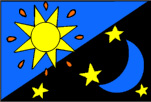

I am a Christian who wants to believe that the Bible is infallible, but I am troubled by several events in the order of creation recorded in the first chapter of Genesis.
 1. On the first day, God created light
and darkness, but it was not until the fourth
day that He created the
sun and other stars. How can there be light without the sun and
other stars?
1. On the first day, God created light
and darkness, but it was not until the fourth
day that He created the
sun and other stars. How can there be light without the sun and
other stars?
2. On the third day, God created vegetation (i.e., plants and trees), but it was not until the fourth day that He created the sun and other stars. How can there be vegetation without the sun and other stars?
3. Also, on the second or third day, God apparently created the earth, but it was not until the fourth day that He created the sun and other stars. How can this be, since there seems to be considerable scientific evidence that the earth was created much later than the sun and the other stars?
For believers and unbelievers alike, there is a need to understand what the original text of Genesis actually says. There has been a tendency to read casually without looking at the original language, and when this is done the problems our e-mailer raises come up. This question is probably given to us more frequently than any other single question.
The problem here is that the Hebrew words in Genesis make a distinction between the process of creating and the process of making. The Hebrew word bara meaning "to create" is different than the Hebrew word asah meaning "to make." The word bara is never used in the Bible in reference to something a human can do. It is only used in reference to something God can do. The Hebrew word asah is used in reference to both things God does and things humans do. Denominational creationists and atheists have tried to maintain that these words mean the same thing, but that is simply not the case. In Genesis 2:3 in summarizing the creation week the Bible says "And God blessed the seventh day, and sanctified it: because that in it he had rested from all his work which God created [bara] and made [asah]." Clearly God says He did both.
The first time that bara is used in the Genesis account is in verse 1. The next time it is used is in verse 21 in reference to life. That means that everything between verse 1 and verse 21 is made, not created. What was created in verse 1? The two things described are the shamayim translated heaven, and the erets translated earth. For a casual reader this is very simple. Shamayim refers to everything above us--the stars, galaxies, the sun, moon, black holes, asteroids, comets, nebulae, etc. Erets refers to everything here--the planet Earth. Notice the order--the cosmos first and then the earth. This verse is undated and untimed. We are not told how long God chose to use to do this creating--just that He did it. In very simple terms, God created everything--that which is above us and the planet Earth itself.
 Someone might object, saying, "Now
wait a minute; the sun and moon
and stars are described in verses 14-19."
That is true, but the word used in those verses is asah, not
bara. These objects were created in verse 1, but
they were put into their proper functioning position in verses 14-19. Why was
that done? "... To divide the day from the night; and let them be
for signs, and for seasons, and for days, and years" (verse 14). The objects
are created in verse 1,
but it is not until verses
14-19 that they could be used for the chronological purposes of
man--our time pieces and calendars. We can speculate about what
went on to do this. Scientists will tell us that it is very
probable that cloud cover placed the earth in a situation where one
could not see the sun or moon or stars. To establish signs,
seasons, days, or years one has to be able to see these objects.
The light that comes to the planet in verse 3 then
is not God providing some miraculous glow, but simply the light from
the sun and moon which can get to the earth; but the sources cannot be
seen clearly enough to establish our timing devices.
Someone might object, saying, "Now
wait a minute; the sun and moon
and stars are described in verses 14-19."
That is true, but the word used in those verses is asah, not
bara. These objects were created in verse 1, but
they were put into their proper functioning position in verses 14-19. Why was
that done? "... To divide the day from the night; and let them be
for signs, and for seasons, and for days, and years" (verse 14). The objects
are created in verse 1,
but it is not until verses
14-19 that they could be used for the chronological purposes of
man--our time pieces and calendars. We can speculate about what
went on to do this. Scientists will tell us that it is very
probable that cloud cover placed the earth in a situation where one
could not see the sun or moon or stars. To establish signs,
seasons, days, or years one has to be able to see these objects.
The light that comes to the planet in verse 3 then
is not God providing some miraculous glow, but simply the light from
the sun and moon which can get to the earth; but the sources cannot be
seen clearly enough to establish our timing devices.
 Those who do not want to take the
Bible this literally will complain
that bara is used in Genesis 1:27 in reference to man, but in Genesis 2:7
the word used to describe man is yatsar
which refers to molding or
shaping in the original language. Genesis 1:27 is referring
to that part of man which is in the image of God--man's soul. We
are spiritually in God's image, not physically in God's image.
The reference in Genesis 2:7
is talking about man's body. The word yatsar is used in reference
to something a potter does, and we are told man was formed of the dust
of the ground (something to which our bodies shall return). It is
sad that not taking the Bible literally in these verses has caused some
to maintain that man does not have a soul, when the first reference to
our unique makeup is here in Genesis.
Those who do not want to take the
Bible this literally will complain
that bara is used in Genesis 1:27 in reference to man, but in Genesis 2:7
the word used to describe man is yatsar
which refers to molding or
shaping in the original language. Genesis 1:27 is referring
to that part of man which is in the image of God--man's soul. We
are spiritually in God's image, not physically in God's image.
The reference in Genesis 2:7
is talking about man's body. The word yatsar is used in reference
to something a potter does, and we are told man was formed of the dust
of the ground (something to which our bodies shall return). It is
sad that not taking the Bible literally in these verses has caused some
to maintain that man does not have a soul, when the first reference to
our unique makeup is here in Genesis.
The accuracy of the sequence of events in the Genesis account is
incredible. It fits every shred of scientific evidence that is
available. The word shamayim used in verse 1 means
"heaved up things" according to Young's
Analytical Concordance.
Many biblical verses tell us that God stretched out the heavens,
strongly suggesting both the expanding universe and the fact that the
universe is accelerating (see Psalm 104:2;
Isaiah 40:22;
44:24; 45:12; 51:13; Jeremiah 10:12;
51:15; etc.).
The creation process is undated and untimed, and the evidence
scientifically is that it took a long period of time. The light
from all of these objects reaches earth in verse 3 and
God begins His creative process of man and man's familiar animals in
the creation week starting in verse 3. Changes in
the earth's atmosphere are described in verses 6-7
allowing man's timepieces to become visible in verses 14-19.
The formation of continental masses  as
we know them are given in verses 9-10
and the plants man knows are described in a sequence of "tender
grasses" (algae, lichen, etc.), followed by herbs (gymnosperms),
followed by flowering plants in verses 11-12
(angiosperms).
as
we know them are given in verses 9-10
and the plants man knows are described in a sequence of "tender
grasses" (algae, lichen, etc.), followed by herbs (gymnosperms),
followed by flowering plants in verses 11-12
(angiosperms).
Animal life begins in verse 20, again given in the correct sequence with water creatures followed by birds, then mammals, and then man. The descriptions are general in these verses. You will not find echidnas, platypuses, viruses, worms, insects, dinosaurs, etc. in these verses. What you do see are the animals Moses was familiar with given in the correct sequence. Remember that Genesis is not written for biologists living in the twenty-first century. It is written for people living over a time stretch of thousands of years in a variety of cultures, languages, and traditions. The fact remains they are given in the correct sequence, and while there are many things we might like to know which are not given, everything that is given is checkable and turns out to be consistent with the best evidence we have available. The Bible is God's word and, as Timothy says, "All Scripture is God-breathed and is useful for teaching, rebuking, correcting, and training in righteousness, so that the man [or woman] of God may be thoroughly equipped for every good work" (2 Timothy 3:16-17, NIV). Let us not allow careless claims and poor understandings rob us of confidence in that statement.
Back to Contents Does God Exist?, SepOct08.